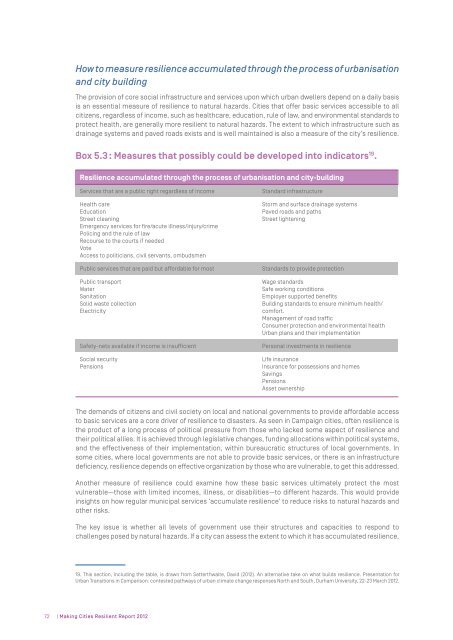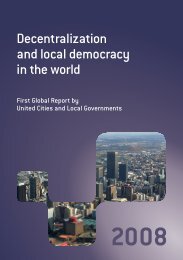Making Cities Resilient Report 2012
Making Cities Resilient Report 2012
Making Cities Resilient Report 2012
Create successful ePaper yourself
Turn your PDF publications into a flip-book with our unique Google optimized e-Paper software.
How to measure resilience accumulated through the process of urbanisation<br />
and city building<br />
The provision of core social infrastructure and services upon which urban dwellers depend on a daily basis<br />
is an essential measure of resilience to natural hazards. <strong>Cities</strong> that offer basic services accessible to all<br />
citizens, regardless of income, such as healthcare, education, rule of law, and environmental standards to<br />
protect health, are generally more resilient to natural hazards. The extent to which infrastructure such as<br />
drainage systems and paved roads exists and is well maintained is also a measure of the city’s resilience.<br />
Box 5.3 : Measures that possibly could be developed into indicators 19 .<br />
Resilience accumulated through the process of urbanisation and city-building<br />
Services that are a public right regardless of income<br />
Health care<br />
Education<br />
Street cleaning<br />
Emergency services for fire/acute illness/injury/crime<br />
Policing and the rule of law<br />
Recourse to the courts if needed<br />
Vote<br />
Access to politicians, civil servants, ombudsmen<br />
Public services that are paid but affordable for most<br />
Public transport<br />
Water<br />
Sanitation<br />
Solid waste collection<br />
Electricity<br />
Safety-nets available if income is insufficient<br />
Social security<br />
Pensions<br />
Standard infrastructure<br />
Storm and surface drainage systems<br />
Paved roads and paths<br />
Street lightening<br />
Standards to provide protection<br />
Wage standards<br />
Safe working conditions<br />
Employer supported benefits<br />
Building standards to ensure minimum health/<br />
comfort.<br />
Management of road traffic<br />
Consumer protection and environmental health<br />
Urban plans and their implementation<br />
Personal investments in resilience<br />
Life insurance<br />
Insurance for possessions and homes<br />
Savings<br />
Pensions<br />
Asset ownership<br />
The demands of citizens and civil society on local and national governments to provide affordable access<br />
to basic services are a core driver of resilience to disasters. As seen in Campaign cities, often resilience is<br />
the product of a long process of political pressure from those who lacked some aspect of resilience and<br />
their political allies. It is achieved through legislative changes, funding allocations within political systems,<br />
and the effectiveness of their implementation, within bureaucratic structures of local governments. In<br />
some cities, where local governments are not able to provide basic services, or there is an infrastructure<br />
deficiency, resilience depends on effective organization by those who are vulnerable, to get this addressed.<br />
Another measure of resilience could examine how these basic services ultimately protect the most<br />
vulnerable—those with limited incomes, illness, or disabilities—to different hazards. This would provide<br />
insights on how regular municipal services ‘accumulate resilience’ to reduce risks to natural hazards and<br />
other risks.<br />
The key issue is whether all levels of government use their structures and capacities to respond to<br />
challenges posed by natural hazards. If a city can assess the extent to which it has accumulated resilience,<br />
19. This section, including the table, is drawn from Satterthwaite, David (<strong>2012</strong>). An alternative take on what builds resilience. Presentation for<br />
Urban Transitions in Comparison: contested pathways of urban climate change responses North and South, Durham University, 22-23 March <strong>2012</strong>.<br />
72 | <strong>Making</strong> <strong>Cities</strong> <strong>Resilient</strong> <strong>Report</strong> <strong>2012</strong>

















